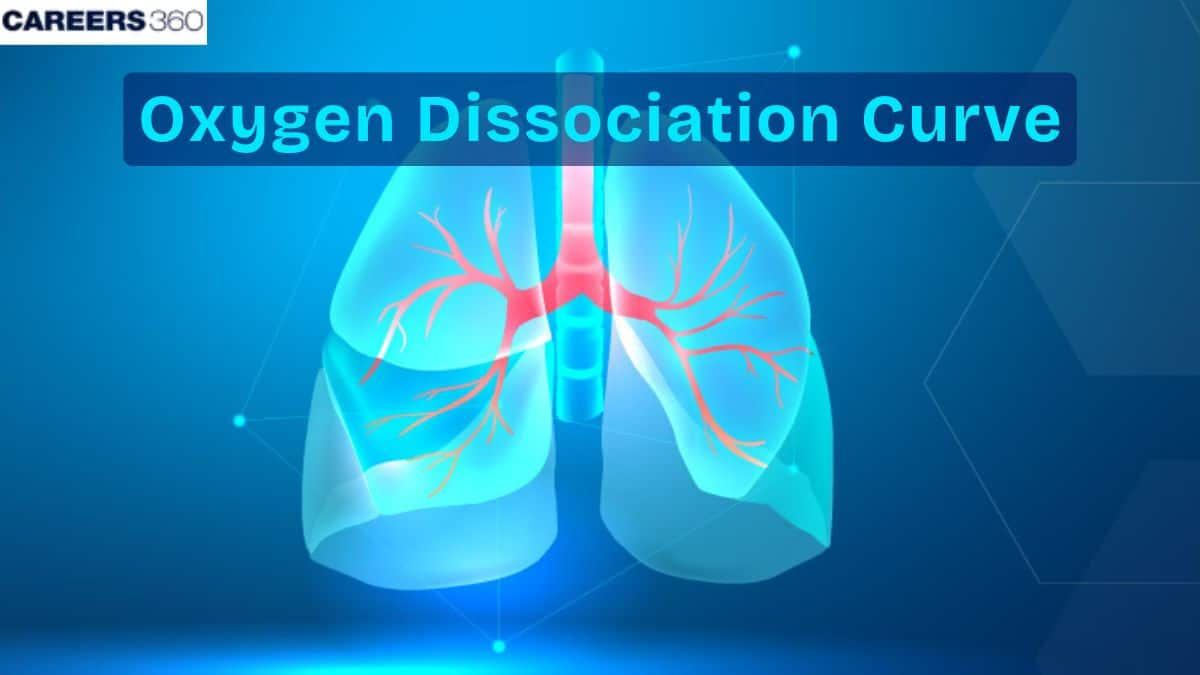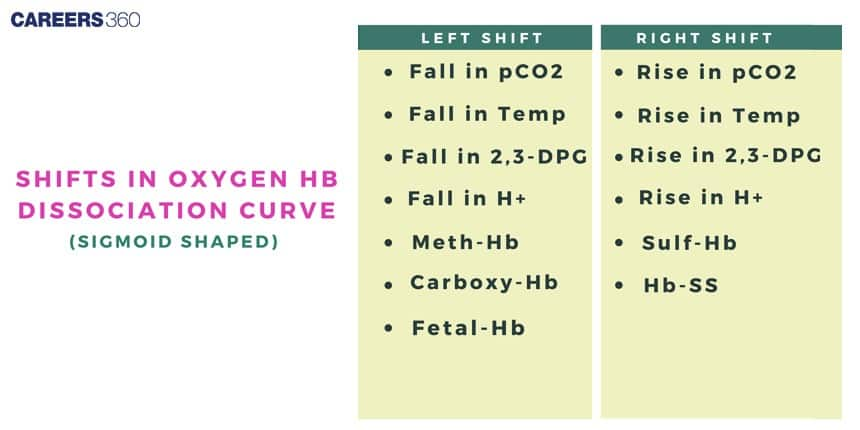Oxygen Dissociation Curve: Definition, Function And Examples
The oxygen dissociation curve explains how hemoglobin binds and releases oxygen under different physiological conditions. It shows the relationship between oxygen partial pressure and hemoglobin saturation, forming a characteristic S-shaped (sigmoid) curve. Understanding ODC is crucial for NEET, nursing, physiology, and respiratory system chapters.
This Story also Contains
- What Is the Oxygen Dissociation Curve?
- Basics of Oxygen Binding
- Factors Affecting The Oxygen Dissociation Curve
- Shifts In The Oxygen Dissociation Curve
- P50 Value — Indicator of Affinity
- Physiological Relevance of Oxygen Dissociation Curve
- Oxygen Dissociation Curve NEET MCQs (With Answers & Explanations)
- Recommended video for Oxygen Dissociation Curve

What Is the Oxygen Dissociation Curve?
The oxygen dissociation curve is central to describing how oxygen is associated with and discharged from haemoglobin in the blood. The theory related to this curve goes on to explain how, effectively, oxygen is supplied to tissues in our body and how carbon dioxide is removed.

Basics of Oxygen Binding
The basics of oxygen binding is discussed below:
Hemoglobin Structure & Function
Heme is a protein in the red blood cells that carries oxygen from the air a person breathes to different parts of their body. The information about the relationship entered above between the partial pressure of oxygen and the percentage of haemoglobin saturated with oxygen is held within a graph.
Cooperative Binding
Hemoglobin binds to oxygen cooperatively. Once an oxygen molecule has bound to the active site, this will increase the affinity for all the remaining sites to bind with the oxygen. This cooperative nature of binding with oxygen gives its characteristic sigmoid shape to the oxygen dissociation curve.
Factors Affecting The Oxygen Dissociation Curve
The factors affecting the oxygen dissociation curve are:
Partial pressure of oxygen (pO2)
This exerts the most marked influence on the curve. High pO2 in the lungs favours haemoglobin binding to oxygen, and values of low pO2 favour the release of oxygen in tissues.
pH (Bohr Effect)
A decrease in pH means an increase in hydrogen ion concentrations—caused a decrease in affinity as P50 increased. Hence shifting the curves to the right, referred to as the Bohr effect.
Carbon dioxide levels
Higher amounts of CO2 will shift the pH further right. Thus, less binding with the oxygen is allowed by haemoglobin—meaning that then more oxygen is released.
Temperature
The curve shifts rightward as temperature increases. This has the effect of lowering haemoglobin's affinity for oxygen.
2,3-Bisphosphoglycerate
This is a molecule that binds with haemoglobin to decrease its affinity for oxygen. The net effect of this binding would be a shift to the right—favouring increased delivery of oxygen to tissues.
Shifts In The Oxygen Dissociation Curve
The shift in the oxygen dissociation curve is discussed below:
Right Shift (↓ affinity, ↑ O₂ delivery)
Less haemoglobin affinity for oxygen. Hence, there will be an improved potential to give off oxygen to the tissues. Increased scavenge due to increased pCO2, higher temperatures, and decreased pH and increased 2,3-BPG.
Left Shift (↑ affinity, ↓ O₂ delivery)
A decreased affinity of haemoglobin to oxygen means a further enhancement in the ability of haemoglobin to give up oxygen to the tissues. This may happen with an increased pCO2, increased temperature, decreased pH, and increased 2,3-BPG.

P50 Value — Indicator of Affinity
It is the value of P50, which is the partial pressure required to produce 50 per cent saturation of haemoglobin. It happens to be a significant measure related to haemoglobin affinity for oxygen. An increase in P50 denotes a rightward shift as opposed to a decrease which signifies a leftward shift.
Physiological Relevance of Oxygen Dissociation Curve
The physiological relevance of oxygen dissociation curve is discussed below:
Oxygen loading in Lungs
An elevated pO2 ensures optimum loading of oxygen onto the haemoglobin of the lungs.
Oxygen unloading in Tissues
Low pO2 synergizes with other tissue factors to allow the offloading of oxygen from the Hb molecule, most effectively delivering it.
Adaptations
There are shifts in the oxygen-dissociation curve, as needed, to enable physical changes to adapt efficiently to the physical change for efficient transfer of oxygen, such as at high altitudes or during exercise.
Pathological Relevance
Carbon monoxide binds much more firmly to haemoglobin than oxygen and therefore decreases its oxygen-carrying capacity, shifting the curve to the left.
Abnormal haemoglobin of sickle cell anaemia shall direct an abnormal oxygen dissociation curve and hence affect the delivery of oxygen.
Oxygen Dissociation Curve NEET MCQs (With Answers & Explanations)
Important topics for NEET are:
Factors affecting the oxygen dissociation curve
Shifts in the oxygen dissociation curve
Practice Questions for NEET
Q1. At high temperatures, the Hb will be less likely to stick to the oxygen and release it into the tissues, this causes the oxygen dissociation curve to shift to
Left
Right
No movement
Slightly left then right
Correct answer: 2) Right
Explanation:
DPG (2,3-diphosphoglycerate) and temperature both shift the oxygen dissociation curve to the right, promoting oxygen release from haemoglobin to tissues. DPG binds to haemoglobin, reducing its affinity for oxygen, especially at lower oxygen concentrations. Increased temperature also decreases haemoglobin's affinity for oxygen, enhancing oxygen delivery during conditions like exercise or fever. These changes help tissues receive more oxygen when metabolic demand is high.
At high temperatures, the Hb will be less likely to stick to the oxygen and release it into the tissues. The curve shifts to the right when the temperature increases.
Hence, the correct answer is option 2) Right.
Q2. Read the following statements
STATEMENT i): the decrease in 2,3 DPG concentration within the red cell shifts the curve to the left.
STATEMENT ii): lower temperature causes a leftward shift in the oxygen dissociation curve.
Choose the correct option:
Statement (i) is correct and statement (ii) is incorrect
Statement (i) is incorrect and statement (ii) is correct
Both statements are wrong
Both statements are correct
Correct answer: 4) Both statements are wrong
Explanation:
Explanation of statement i) : Statement i) is correct because The position of the oxygen dissociation curve (ODC) is modulated by 2,3-diphosphoglycerate (2,3-DPG). Decreases in 2,3-DPG concentration within the red cell shift the curve to the left, whereas increases in concentration cause a shift to the right of the ODC.
Explanation of statement ii): Statement ii) is also correct because The effect of temperature on the curve is relatively straightforward. Oxygen unloading is favored at higher temperatures which will cause a rightward shift. On the other hand, lower temperatures will cause a leftward shift in the dissociation curve.
Hence, the correct answer is option 4) Both statements are correct.
Q3. Which of the following will shift the Oxygen dissociation curve to the left?
a) Increase hydrogen ions
b) Increase 2,3-DPG
c) Decrease CO2
d) Decrease Temperature
a and b
c and d
a and c
b and d
Correct answer: 2) c and d
Explanation:
Both of these elements would cause the oxygen dissociation curve to move to the left increasing haemoglobin's affinity for oxygen and its ability to hold onto oxygen.
Decrease in CO2: The blood becomes less acidic (pH rises) when CO2 levels are lower which raises haemoglobin's affinity for oxygen and causes the curve to move to the left.
Temperature decrease: The curve moves to the left as a lower temperature also improves haemoglobin's affinity for oxygen.
The oxygen dissociation curve is shifted to the right by increases in 2,3-DPG (b) a byproduct of metabolism and hydrogen ions (a) which raise blood acidity. Haemoglobin can more easily provide oxygen to tissues that require it as a result.
Hence, the correct answer is option 2) c and d.
Also Read:
Recommended video for Oxygen Dissociation Curve
Frequently Asked Questions (FAQs)
The oxygen dissociation curve is a graph showing the relationship of partial pressure of oxygen with per cent haemoglobin saturated with oxygen.
Increased carbon dioxide, lower pH, increased temperature, and increased 2,3-BPG all produce a rightward shift. Therefore, the rightward shift gives haemoglobin a lesser affinity for oxygen.
Changes in the oxygen affinity of haemoglobin due to changes in pH and carbon dioxide generally a shift to the right in the oxygen dissociation curve.
Because there is cooperative binding between the molecules of oxygen in haemoglobin, the binding of one molecule of oxygen increases the affinity for the binding of other molecules of oxygen.
Anemia states have decreased total haemoglobin concentrations and therefore may shift the right oxyhaemoglobin dissociation curve, indicating a reduced affinity for oxygen and a reduced carrying capacity for it.